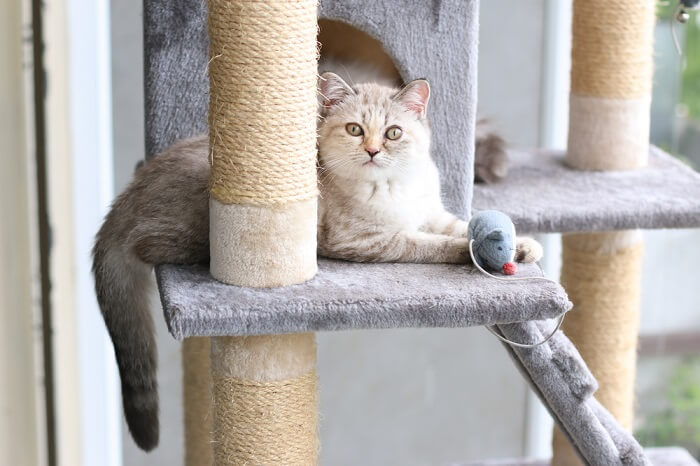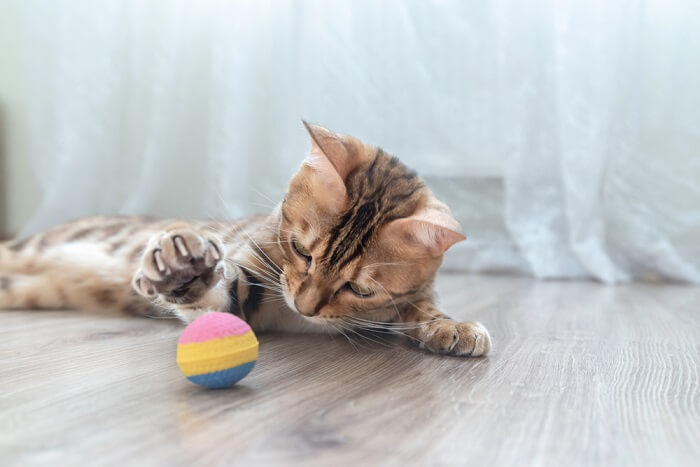
Cats are generally happy in their own company and spend most of their time sleeping, so it’s easy to mistakenly assume that they can be left to entertain themselves.
However, playing with your cat is an essential part of their care. It helps keep them mentally and physically healthy, as well as reinforces the bond you share with them. Read on to find out how long you should play with your cat and how to end a play session appropriately.
The benefits of play include mental and physical stimulation and a strengthened bond between you and your cat. Aim to play with your cat for 30 to 40 minutes per day, split between several sessions. Ending a play session appropriately prevents frustration.Key Takeaways
How Much Play Time Does a Cat Need?
The best length of play time will vary with each cat. Aim for a total of 30 to 40 minutes of play per day, ideally split between two to three sessions. Cats don’t tend to play for sustained periods of time, as you might have already noticed.
Naturally, cats spend a lot of time sleeping and saving up their energy. In between all their naps, they will wake up for short bursts of activity. So, the best way to set up play time is to mimic these innate patterns.
Kittens, with all their fizzing energy, are often highly motivated to engage in play and will enjoy longer periods of interaction in this way. It’s still important for adult cats to play, though the duration and frequency will decrease with age.
Older cats might need some gentle encouragement, especially if their mobility and energy levels are declining. Once you have established playtime into your daily schedule, you will be able to tailor the sessions to your cat’s receptivity and needs.
How Long Do Cats Play With Each Other?
Cats’ playtime can range from short bursts to more extended sessions. Kittens tend to have longer and more frequent play, spanning from a few minutes to around half an hour, while adult cats typically engage in shorter sessions, roughly 10-15 minutes.
As cat behavior expert Pam Johnson-Bennett notes, “Play sessions should be tailored to the individual cat’s preferences and energy levels.” Understanding a cat’s natural behavior and allowing them to guide the duration of play fosters a healthier interaction, ensuring they’re engaged without feeling overwhelmed or disinterested.
How Long Should a Cat Play Session Be and How to End a Play Session?

Although cats sometimes play on their own, it’s still important to engage in play sessions with them.
A typical play sessions is around 10-15 minutes. Ending a play session too early can cause issues like frustration. This is due to your cat still being in an aroused and stimulated state. They might then release this energy by coming after you or chasing other cats in the house.
If your cat walks away from the toy, don’t automatically assume that they are finishing the game themselves. Think about how a cat would act in the wild: they usually stalk their prey, crouching low and watching from a distance, before going in for the attack and pouncing.
Wait and see what your cat does next. If they turn their attention back to the toy, then they most likely want to continue playing. However, if they leave the room and don’t return or go to sleep, then you can safely assume that the game is over.
When you are trying to bring the game to an end, make sure to gradually slow down the movements of the toy to imitate injured or dying prey. Allow your cat to successfully catch the toy more frequently. On the final catch, drop the toy.
Your cat might continue to engage with it by biting or shaking. If you want to remove the toy, only do so once your cat has left as they might think you are inviting them for another play session if they see the toy moving. Offering a treat at the end to reward your cat for their successful stalking and hunting is always a good idea.
What Are the Benefits of Playing With Your Cat?

Indoor cats especially benefit from the mental stimulation and physical exercise provided by play time.
Playing with your cat brings many benefits. Taking care of a cat isn’t just about providing for their basic physical needs, such as shelter, food, and water. We also need to make sure they have plenty of physical and mental stimulation so that they can lead happy and fulfilled lives. Outdoor cats have free access to roam and can explore as much as they want.
Indoor cats can still have interesting lives but they depend on us to offer plenty of environmental enrichment. If your cat stays indoors only, then playing with them is all the more important.
Interactive play with your cat appeals to their hunting instincts so that they can still exhibit the behaviors of catching prey. It also gets them moving so they burn off calories, preventing obesity and further health conditions, like diabetes.
Without proper stimulation, your cat might become bored, stressed, and frustrated. This can then lead to undesirable behaviors, such as aggression, excessive vocalization, overgrooming and inappropriate urination or defecation.
Last, but not least, incorporating playtime with your cat into your daily routine is a great way to strengthen the relationship between you both. This quality time can improve mutual love and trust.
What Are the Best Toys for Cats?
Every cat will have their own preferences when it comes to toys. Take some time to figure out which ones tickle your cat’s fancy the most. Cat toys come in many different shapes and forms. Wand toys or fishing rod toys are great for interactive play. You can easily control the movements of the toy to mimic prey and your hands are kept out of reach from your cat’s teeth and claws.
Final Thoughts
So, while cats do indeed sleep a lot, they still need to be encouraged to engage in short bursts of play and activity several times a day. Ideally, you should aim to incorporate 30 to 40 minutes of playtime into their daily routine.
Playing with your cat provides many benefits for your cat, including improving their bond with you, and their mental and physical well-being. Now that are you equipped with all this knowledge, grab your cat’s favorite toy and spend some time interacting with them!
Also Read: Why Do Cats Play With Their Food?
Frequently Asked Questions
How long should I play with my cat before bed?
Spending around 10 minutes playing with your cat before bedtime is a good idea. This allows them to use up some energy and helps tire them out before winding down for the night. You can follow this play session with their last meal or a snack. In this way, you mimic their natural pattern of hunting, eating, and sleeping.
Should I play with my cat every day?
Yes, you should set aside some time every day to play with your cat. About 30 to 40 minutes of playtime daily is ideal. Playing is a great way to keep them both mentally and physically stimulated. This is all the more important if your cat is kept indoors only. Playtime also helps to strengthen the bond you have with them.
What happens if you don't play with your cat?
If you don’t engage in play with your cat and they don’t have much to do, they can easily become bored, stressed, and frustrated. This can then lead to undesirable behaviors, such as aggression, overgrooming, and excessive vocalization.
-
Atkinson, T. (2018). Practical Feline Behaviour. Oxfordshire, UK: CAB International







